Related Research Articles

The Dytiscidae – based on the Greek dytikos (δυτικός), "able to dive" – are the predaceous diving beetles, a family of water beetles. They occur in virtually any freshwater habitat around the world, but a few species live among leaf litter. The adults of most are between 1 and 2.5 cm (0.4–1.0 in) long, though much variation is seen between species. The European Dytiscus latissimus and Brazilian Megadytes ducalis are the largest, reaching up to 4.5 cm (1.8 in) and 4.75 cm (1.9 in) respectively. In contrast, the smallest is likely the Australian Limbodessus atypicali of subterranean waters, which only is about 0.9 mm (0.035 in) long. Most are dark brown, blackish, or dark olive in color with golden highlights in some subfamilies. The larvae are commonly known as water tigers due to their voracious appetite. They have short, but sharp mandibles and immediately upon biting, they deliver digestive enzymes into prey to suck their liquefied remains. The family includes more than 4,000 described species in numerous genera.
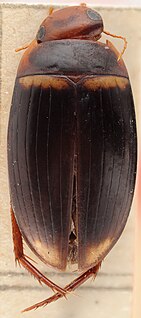
Copelatus is a large genus of small diving beetles. There are some 470 described species in the genus, found worldwide, but they are most diverse in tropical South America, Africa and South-East Asia.

Hygrotus is a genus of beetle in family Dytiscidae. It contains two subgenera and about 70 species, including:

Megadytes is a genus of diving beetles in the family Dytiscidae. They are found in slow-moving or static freshwater habitats throughout most of the Neotropics, ranging from Florida and Mexico, through the West Indies and Central America, to South America as far south as central Argentina. The adult beetles measure 1.65–4.75 cm (0.6–1.9 in) long depending on the exact species and the largest is also the largest in the family.

Rhantus is a genus of beetle in family Dytiscidae. There are about 100 species distributed worldwide. They often live in pools and marshy habitat types. Several species have colonized oceanic islands and become endemics.

Agabus is a large genus of predatory aquatic beetles in the family Dytiscidae, proposed in 1817 by William Elford Leach and named after Agabus, an early follower of Christianity. The adult beetles are moderate-sized, 5 to 14 mm long. The genus is primarily Holarctic in distribution, with only a few species known from the Afrotropical and Neotropical realms. Three species of Agabus, namely A. clypealis, A. discicollis and A. hozgargantae are endangered according to the IUCN Red List. The division into subgenera is not widely accepted. However, a number of species groups are recognized after the works of David J. Larson and Anders N. Nilsson. The genus is probably polyphyletic or paraphyletic. In a recent study of mitochondrial DNA, Agabus was found paraphyletic with respect to several of the species groups of Platambus, a closely related genus in the tribe Agabini. Lately the taxonomy of the genus has been revised, and some groups of species were transferred from Agabussensu stricto to other genera in the tribe Agabini.
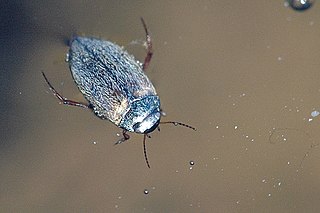
Hydroporus is a genus of water beetles native to the Palearctic, the Nearctic, the Near East, and North Africa. It contains the following species:
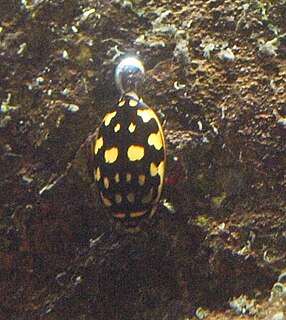
Thermonectus is a genus of beetle in family Dytiscidae. This genus is native to the New World, and mainly from warm temperate to tropical in distribution, but one species, T. basilaris occurs as far north as southern Ontario, Canada. They inhabit a wide range of freshwater habitats with static water and are often common. They are generally about 0.8–1.5 cm (0.3–0.6 in) long and a few species from desert pools in North America have a distinct yellow-spotted pattern on a black background.
Neoporus is a genus of beetle in the family Dytiscidae. These are the predaceous diving beetles, a family of water beetles. Their larvae are commonly known as water tigers. Neoporus is one of over 160 genera in family Dytiscidae.
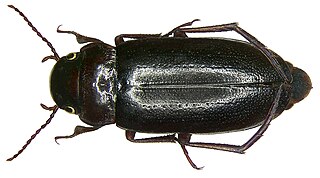
Carabdytes is a genus of predaceous diving beetles in the family Dytiscidae. Carabdytes upin was formerly the sole species of this genus, but nine species in the genus Rhantus were transferred to Carabdytes as a result of research published by Balke et al. in 2017.

Sandracottus is a genus of beetles in the family Dytiscidae. These aquatic beetles are found in ponds and slow streams from South Asia east to southern Japan, and south to Australia. They are generally about 1–1.5 cm (0.4–0.6 in) long and often have attractive markings.
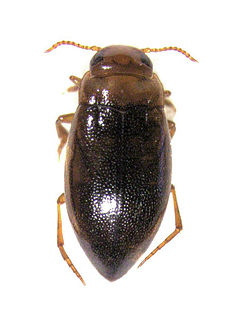
Liodessus is a genus of beetles in the family Dytiscidae, containing the following species:
Heterosternuta is a genus of beetles in the family Dytiscidae, containing the following species:
Desmopachria is a genus of beetles in the family Dytiscidae, containing the following species:
Vatellus is a genus of beetles in the family Dytiscidae, containing the following species:
Batrachomatus is a genus of beetles in the family Dytiscidae, containing the following species:

Suphisellus is a genus of beetles in the family Noteridae, containing the following species:

Hyphydrini is a tribe of predaceous diving beetles in the family Dytiscidae. There are about 16 genera and more than 390 described species in Hyphydrini.

Meridiorhantus is a genus of predaceous diving beetles in the family Dytiscidae. There are about five described species in Meridiorhantus, found in the Neotropics and North America. These species were formerly members of the genus Rhantus, but were moved to Meridiorhantus when it was created by Balke et al. in 2017.
References
- ↑ Dytiscidae Species List at Joel Hallan's Biology Catalog. Texas A&M University. Retrieved on 7 May 2012.
| | This Dytiscidae-related article is a stub. You can help Wikipedia by expanding it. |